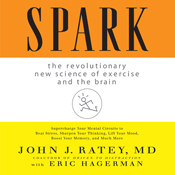
I think I’m in love with Dr. John J. Ratey. What’s not to love about this declaration:
What I aim to do here is to deliver in plain English the inspiring science connecting exercise and the brain and to demonstrate how it plays out in the lives of people.” p. 7, Spark: The Revolutionary New Science of Exercise and the Brain
Amen!! Now that I’ve just outted myself as an ecstatic nerd, let me explain.
Lately I’ve been on a crusade to get more people “using the brains in their whole body.” This is a deeply personal crusade, as well as a professional one.
PE Classes That Teach Kids to Think!?
As an educator, I got especially excited about Ratey’s case study of a revolutionary approach to PE classes. Imagine– heart rate monitors replacing dodge ball:
The essence of physical education in Naperville 203 is teaching fitness instead of sports. The underlying philosophy is that if physical education class can be used to instruct kids how to monitor and maintain their own health and fitness, then the lessons they learn will serve them for life. And probably a longer and happier life at that. Spark, p. 12
Ratey presents study after study that proves that fitness is essential to maximizing not only people’s health & happiness — but also their smarts. Turns out we think especially clearly and effectively after we engage in:
- 30 minutes of aerobic activity, and
- complex physical tasks.
This kind of fitness literally builds new neuropathways in our brains, as well as strengthens old ones. As the coaches in Naperville 203 are fond of saying, “in [the PE] department, we create the brain cells. It’s up to the other teachers to fill them” (Spark, p. 19).
MuseCubes Help Us Remember to Move
I’ve known through experience that movement effects my thinking. In fact, the more I move, the more I experience freedom, passion, balance, and productivity.
What’s amazing to me, though, is how often I forget to move! Yesterday I spent over 6 hours on the computer. I woke up this morning in physical pain, emotionally drained, and without an ounce of alertness.
As a heady intellectual, I’m constantly looking for ways to be more embodied. That’s where MuseCubes come in.
Now, a MuseCubes break takes 30 seconds, not the recommended 30 minutes. However, I notice this: the more I remember to roll the MuseCubes, the more I choose to move in other aspects of my life, too.
For example, on days that I wiggle and howl with the MuseCubes, I’m more likely to take a 10 minute dance break, and then ALSO go on a longer walk. Movement inspires more movement, which eventually builds up to fitness! Ahhh, I love incrementality.
Ratey himself says that “the most important thing is to do something” (Spark, p. 250). And if that something ultimately adds up to six hours a week of exercise on behalf of your brain — well, that sure is smart!
OK, speaking of moving, I’m gonna finish this blog post and walk to the library to return Ratey’s book. What are you going to do to exercise today?

I’ve found exercise to be really important to my mental health, so that makes sense to me! And you’ve inspired me to get out for a quick walk while it’s not raining. Hopefully I won’t get drenched!
I notice that when I don’t go to dance class for a long time (ie more than a week), I get grumpy and tired. I feel less energized and less motivated. I have been loving my new practice of going to Modern Dance class with Kara Davis at the San Francisco Dance Center every Wednesday morning. I try to get another class or two in each week, but I have dedicated that time to that class so that I know I will not go longer than a week without dancing hard!
I know not everyone is interested in going to a modern or ballet dance class. InterPlay is another excellent place for people to move. Last Tuesday, everyone did so much beautiful movement in our Tuesday InterPlay Drop-In class. I know new neural pathways were being created as we practiced cognitive awareness during improvisation.
Dear Ecstatic Nerd,
I love that name, reminds of a sufi or dervish kind of blogger. I do not feel as good if I do not exercise. Thanks for the quotes from John Ratey. I will have to get that book. Mike Logan
THanks for the heads up on the book — adding it to my list.